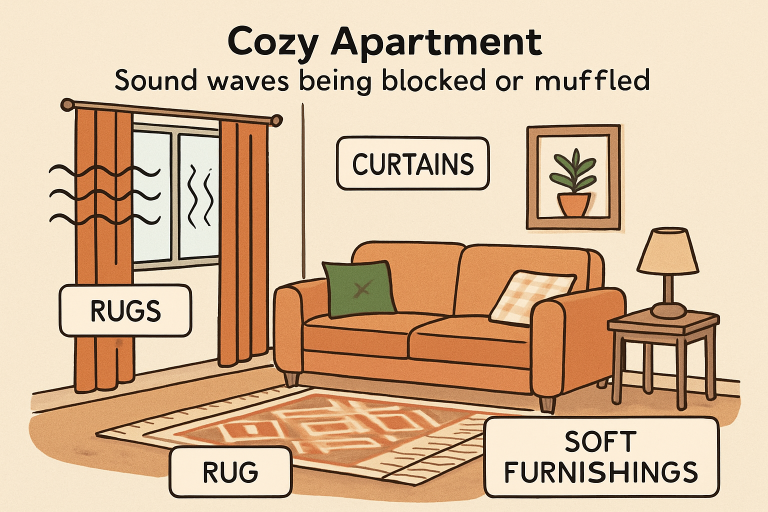Noise can easily disrupt apartment living, making it hard to relax or focus, particularly in vibrant urban settings. Whether you live near busy streets or have neighboring units close by, reducing noise is essential for a peaceful home environment. For those searching for a new place, Cherry Creek Apartments Denver offer a strong combination of location and sound-minimizing amenities to help ensure greater tranquility. If you’re already settled in your apartment, exploring simple strategies for reducing noise can make everyday life much more enjoyable and improve your overall well-being.
This guide covers practical methods to quiet your apartment, using accessible tips and proven solutions suitable for renters and owners alike.
1. Seal Gaps and Cracks
Noisy distractions often slip through unnoticed gaps around your doors and windows. These small spaces act as entry points for sound, allowing everything from hallway chatter to street activity to infiltrate your apartment. The solution is simple: use weather stripping or an acoustic sealant to close those unused cracks and openings. Door sweeps can also be added along the bottom of your doors to prevent noise from leaking through. By sealing up gaps, you can enjoy a noticeable reduction in unwanted sounds.
2. Add Rugs and Carpets
While tile and hardwood floors are popular for their modern look, they tend to reflect and amplify noise. Covering these surfaces with area rugs or plush carpets will help absorb sound, muffling footsteps and other household activities. For an even more effective approach, layer a thick rug pad underneath your chosen coverings. Not only do rugs help create a quieter home, but they also add softness and visual warmth to your living area.
3. Use Heavy Curtains
Windows can let in much more than just sunlight—they’re also a primary source of external noise, from passing traffic to neighborhood commotion. Installing heavy, dense curtains that extend beyond the window edge makes a big difference in soundproofing. For best results, choose curtains designed specifically for noise reduction or blackout purposes, as these provide superior insulation against both noise and temperature fluctuations. You’ll gain peace and comfort, plus an added boost in privacy and energy savings.
4. Rearrange Your Furniture
The way you arrange your apartment’s furniture greatly affects how sound moves through your home. Positioning large items like bookcases, armoires, or tall cabinets against walls that you share with neighbors acts as an effective sound barrier. Sofas placed against noisy walls or floating in open space can also block and diffuse sound waves. Use this opportunity to creatively optimize your layout for both aesthetic appeal and acoustic comfort.

5. Install Acoustic Panels
Sometimes, basic measures aren’t enough to tackle persistent noise challenges. This is where acoustic panels come in. These specially engineered panels absorb, rather than reflect, sound waves, making them ideal for apartments prone to echoes or persistent external noise. They’re available in a wide range of colors and designs, letting you enhance your decor while boosting quiet. Simply mount them on shared walls or ceilings where you experience the most noise for an instant improvement in sound quality and comfort.
6. Utilize White Noise Machines
When you can’t fully control external sounds, masking them becomes the next best option. White noise machines, such as the LectroFan EVO, offer continuous sounds—like gentle fan noise, ocean waves, or static—that blend away distracting background noise and help with sleep. As Tom’s Guide explains, these compact devices are especially effective for renters or city dwellers dealing with everyday noise challenges.
7. Communicate with Neighbors
Many apartment noise issues can be solved with simple, neighborly communication. Neighbors often don’t realize their music, pets, or activities are disturbing others until someone speaks up. A polite, respectful conversation can go a long way in finding solutions that work for both parties. Consider suggesting quiet hours or shared courtesy arrangements to foster a friendlier, more harmonious community environment.
8. Incorporate Soft Furnishings
Don’t underestimate the sound-absorbing qualities of soft home accessories. Cushions, throws, poufs, and upholstered furniture all help reduce noise reflection within a room. These items not only soak up sound but also introduce personality and coziness to your living space, making your apartment both quieter and more inviting.
9. Conclusion
Reducing noise in your apartment can be easier than you think. From sealing gaps and adding plush textures to trying out affordable technology, combining several strategies can transform a noisy space into a peaceful retreat. Begin with the methods that best fit your lifestyle and gradually layer more solutions to suit your needs. Your ears—and your sense of calm—will thank you.
Consider starting with heavy curtains or blackout drapes, which not only block light but also absorb sound from outside. Adding rugs or carpets, especially with thick padding, can significantly reduce noise bouncing off hard floors. Wall hangings like fabric panels or acoustic art can further muffle sound and add personality to your space. For a quick fix, weather stripping around doors and windows helps seal out street sounds and drafts. If you’re dealing with persistent noise, even a white noise machine or noise-canceling headphones can offer immediate relief.
